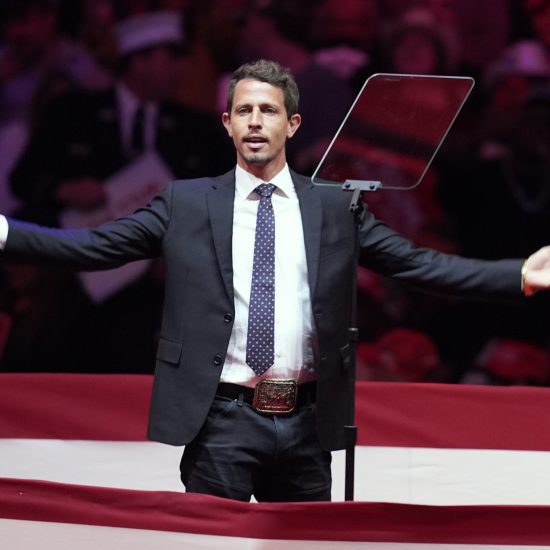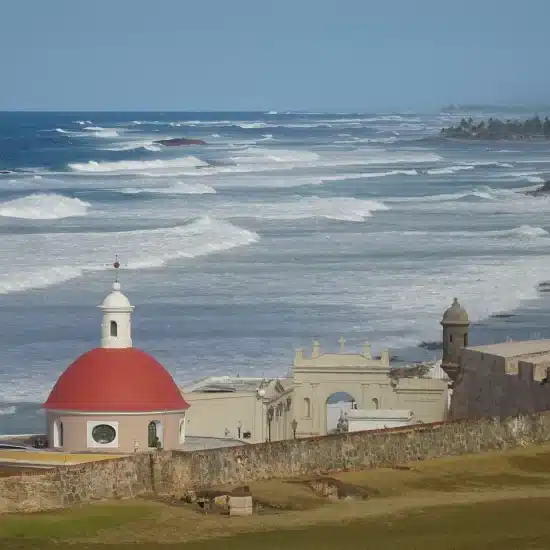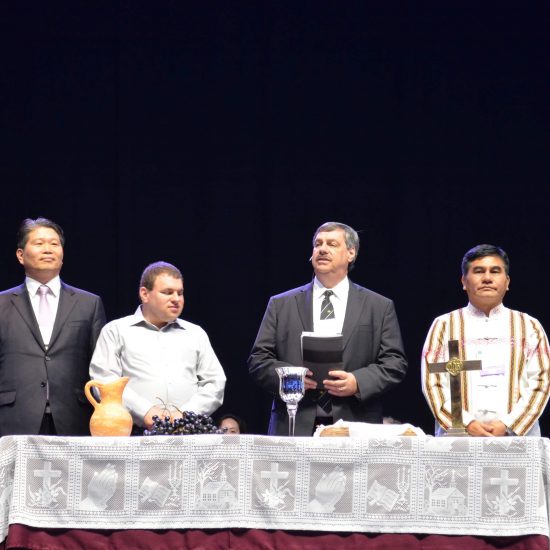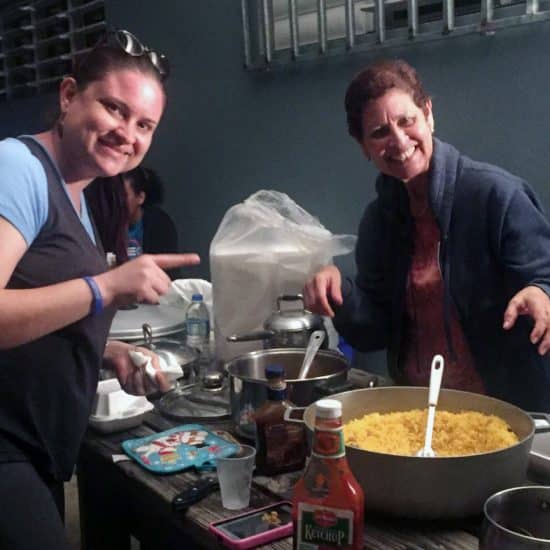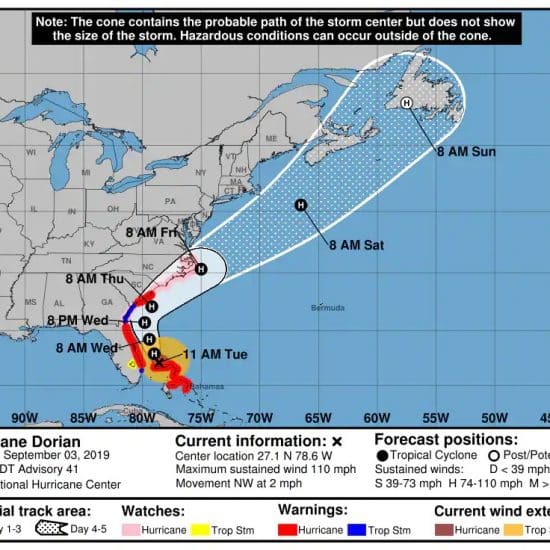GUAYNABO, Puerto Rico (BP) — “Before Maria and after Maria” is the word on the streets of Puerto Rico. “That’s how life changed,” native Puerto Rican and Southern Baptist minister Jonathan Santiago told Baptist Press a year after the hurricane.
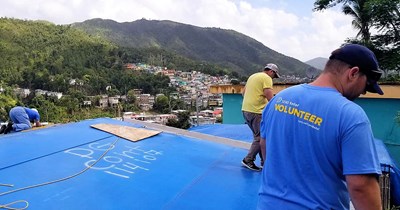 Send Relief volunteers replace a roof on one of tens of thousands of homes still in need of repair in Puerto Rico a year after Hurricane Maria devastated the island. Send Relief photoIn Santiago’s observation, churches including Southern Baptist congregations lost about 35 percent of their attendance. Congregational financial giving is down because many members still on the island lost their jobs. Several schools remain closed. Homes still need repairs from storm damage. Many people are hopeless, resorting to suicide in greater numbers and affecting an official death toll already near 3,000.
Send Relief volunteers replace a roof on one of tens of thousands of homes still in need of repair in Puerto Rico a year after Hurricane Maria devastated the island. Send Relief photoIn Santiago’s observation, churches including Southern Baptist congregations lost about 35 percent of their attendance. Congregational financial giving is down because many members still on the island lost their jobs. Several schools remain closed. Homes still need repairs from storm damage. Many people are hopeless, resorting to suicide in greater numbers and affecting an official death toll already near 3,000.
“I don’t think I know of any church who continues to be the same kind of church,” said Santiago, who moved back to his homeland Aug. 2, working as coordinator of the North American Mission Board’s Send Relief ministry center in Guaynabo. “There’s still so many families, so many elderly, so many single moms and so many families with children who still need a lot of help trying to get back on their feet, and (to) have the blessing just to live in a dry home.
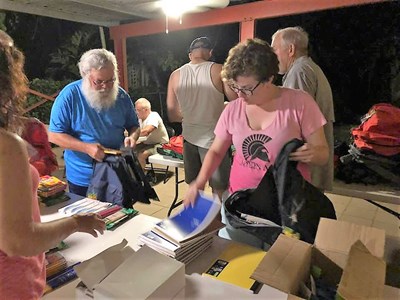 Volunteers from a stateside Southern Baptist church prepare bags of supplies for Puerto Ricans still recovering from Hurricane Maria. Send Relief photo“I heard a testimony of a lady who the only part of her home that was concrete was her bathroom and a little bit of a closet, and because the roof was still leaking,” Santiago said, “that’s where she was living.”
Volunteers from a stateside Southern Baptist church prepare bags of supplies for Puerto Ricans still recovering from Hurricane Maria. Send Relief photo“I heard a testimony of a lady who the only part of her home that was concrete was her bathroom and a little bit of a closet, and because the roof was still leaking,” Santiago said, “that’s where she was living.”
Tens of thousands of homes remain storm-damaged in the U.S. territory that already suffered from a poverty rate approaching 50 percent when Hurricane Maria devastated the island a year ago today, Sept. 20, said Send Relief President David Melber.
“There’s still just massive needs,” Melber said. “It’s just despair and discouragement … that this is taking so long, and I think our own government, FEMA, is planning to be there 10 years … just to see the island reestablished.”
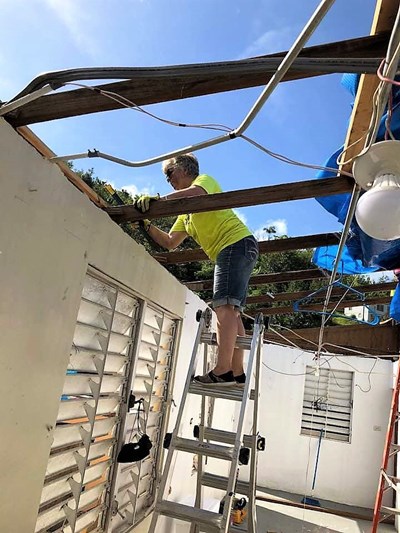 Send Relief volunteers trained in Southern Baptist Disaster Relief remove debris that is still prevalent in Puerto Rico a year after Hurricane Maria struck. Send Relief photoPuerto Rico after Maria is ripe for the Gospel, said Oklahoma pastor and Puerto Rican native Felix Cabrera, who is taking up residence again on the island in December as NAMB’s church planting catalyst.
Send Relief volunteers trained in Southern Baptist Disaster Relief remove debris that is still prevalent in Puerto Rico a year after Hurricane Maria struck. Send Relief photoPuerto Rico after Maria is ripe for the Gospel, said Oklahoma pastor and Puerto Rican native Felix Cabrera, who is taking up residence again on the island in December as NAMB’s church planting catalyst.
“For us, Puerto Rico is at a suitable time to go and preach the true Gospel, showing God as He is,” said Cabrera, lead pastor of Iglesia Bautista Central in Oklahoma City and second vice president of the Southern Baptist Convention. In January, he will plant City of God Baptist Church (Iglesia Bautista Ciudad de Dios) in San Juan.
“The problem in Puerto Rico on a spiritual level is that many sincerely believe that they are Christians, but their god is money, possession, status, wealth, prosperity, etc.,” Cabrera told BP. “Hurricane Maria shook not only the governmental and social structures but the concept of God that many pseudo-Christians had. (They) lost their gods and their idols because Maria took them away or destroyed them.”
Cabrera sees opportunity to point out “the rebellion and sin of man and the work of Christ, and call men to repentance,” he said. “Hurricane Maria, for the one who had a wrong concept of God, has been devastating. For those who recognize that God is sovereign and orchestrates all things, we see this crisis as an opportunity to make Christ known and see a revival, a true revival, lives transformed.”
Santiago agrees.
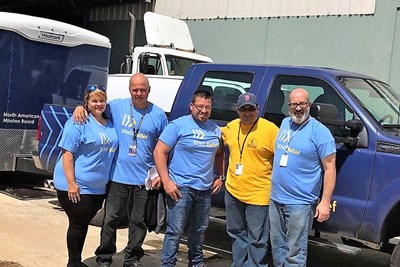 Jonathan Santiago (in yellow shirt), is coordinator of the North American Mission Board Send Relief Ministry Center in Guaynabo, Puerto Rico . Send Relief photoMaria “gave the local church the opportunity to once again renew their passion and vision to reaching the community and being good stewards of what God was giving them to reach the community with the Gospel,” said Santiago, former evangelism catalyst for the Baptist Convention of New York.
Jonathan Santiago (in yellow shirt), is coordinator of the North American Mission Board Send Relief Ministry Center in Guaynabo, Puerto Rico . Send Relief photoMaria “gave the local church the opportunity to once again renew their passion and vision to reaching the community and being good stewards of what God was giving them to reach the community with the Gospel,” said Santiago, former evangelism catalyst for the Baptist Convention of New York.
“The church before Maria is not the same church after Maria,” Santiago said. “I think every pastor, every church planter has embraced the calling to once again make the community and the lost people the priority of their ministry.”
Melber encourages Southern Baptists to choose Puerto Rico for mission trips, where the Send Relief ministry center can house 100 volunteers. No passport is needed to travel there.
“It’s kind of one of the most convenient ways to take what feels like an international trip,” Melber said, “but it’s not an international trip. It’s a trip to a U.S. territory.” He encourages Southern Baptists to continue to pray for the island as it struggles to recover.
For volunteers who can commit three weeks to recovery work there, Send Relief covers travel, housing and food, Santiago said, and gives expense stipends to those unable to stay as long. FEMA is providing building materials at no cost.
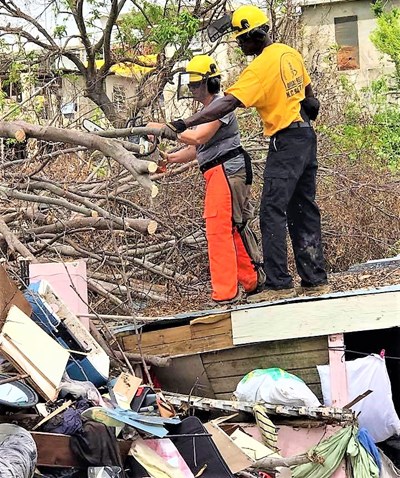 Send Relief volunteers trained in Southern Baptist Disaster Relief remove debris that is still prevalent in Puerto Rico a year after Hurricane Maria struck. Send Relief photo“We would love to have anybody that wants to come and be part of a team to rebuild roofs and put a coating of sealant on concrete roofs, and replace doors and windows,” he said. “We would be happy to host them.”
Send Relief volunteers trained in Southern Baptist Disaster Relief remove debris that is still prevalent in Puerto Rico a year after Hurricane Maria struck. Send Relief photo“We would love to have anybody that wants to come and be part of a team to rebuild roofs and put a coating of sealant on concrete roofs, and replace doors and windows,” he said. “We would be happy to host them.”
Disaster relief training is not required for volunteers, and registration is available at SendRelief.org.
“The requirement is anybody who is willing and able, who is physically able, and spiritually willing to come assist,” he said. “We have crew leaders who are the ones who are experts in building… Anybody who’s willing and able to come assist, we won’t say no to them.”
Amid the devastation Cabrera sees resilience and beauty.
“I see resilient people that have not allowed the house to fall on top of them and are trying to move forward,” Cabrera said. “An economy, that did not take off, is now showing signs of improvement step by step. Many who left the island a long time ago (before Maria) are now returning, and although the hurricane showed us the tremendous governmental, structural and social deficiencies that we had, I think we see light at the end of the tunnel.”

